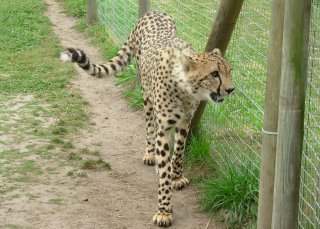
This beautiful cheetah is why Morocco is at Cheetah Outreach. Anatolian Shepherd dogs (ASDs) are one of the solutions to the declining number of free ranging cheetah in Africa. ASDs instinctively protect the livestock they grow up with and eliminate livestock loss. While ASDs protect the livestock, farmers are less likely to find cheetah on their farmlands and thus are less likely to trap or shoot the cheetah. This improves the cheetah's chance of survival.

The cheetah has, in the past, been a companion to kings and pharaohs, as well as a trained hunting partner. In 1900, the cheetah population numbered about 30,000 cheetah in Africa and Asia, yet just 6 years ago there were only 12,500 in Africa and 200 in Iran. (Cheetah became extinct in India in the 1950's.) This magestic animal, that can accelerate from 0 to 45 mph in 2 seconds and run up to 70 mph, is endangered due to a number of reasons. The main reason is that humans are moving in on their habitat. There is also a decrease in prey as well as competition from other predators. As their population becomes fragmented, inbreeding depletes their numbers as well. Mortality of cubs under 6 months old is very high.

To help Cheetah Outreach save the cheetah, visitors can pay for an encounter with an ambassador cheetah. I was privileged to have one of these personal cheetah encounters. Their loud purr is absolutely amazing, and I was witness to the affection given between the cheetah handlers and the cheetah. (In fact, I'll share a picture tomorrow of a cheetah sucking the thumb of his handler, and some other priceless pictures!) Just look at this aloof yet gentle cat! However, the lion is more powerful, the leopard a skilled climber able to pull their catch away from other predators into trees, and large packs of wild dogs can outnumber the cheetah and steal their kill. Scavengers like jackals and hyenas will also try to make cheetah abandon their kill. Sadly, we are seeing the results from encroachment on the land as the land is claimed for agricultural use. Cheetah numbers continue to decline as there is less room for the cheetah and thus more competition between predators for food.

The staff at Cheetah Outreach adore their animals and maintain an immaculate facility for the cheetah to thrive in. They are actively working with farmers and communities to improve the cheetah's chance of survival. Using the cheetah as a learning tool, they visit classrooms to educate children about the need for conservation. They deliver curriculum-based resources for classroom use. Now they are developing an Anatolian Shepherd dog breeding program in order to place more puppies with farmers in the battle to save the cheetah! But there's more to come tomorrow!

 This beautiful cheetah is why Morocco is at Cheetah Outreach. Anatolian Shepherd dogs (ASDs) are one of the solutions to the declining number of free ranging cheetah in Africa. ASDs instinctively protect the livestock they grow up with and eliminate livestock loss. While ASDs protect the livestock, farmers are less likely to find cheetah on their farmlands and thus are less likely to trap or shoot the cheetah. This improves the cheetah's chance of survival.
This beautiful cheetah is why Morocco is at Cheetah Outreach. Anatolian Shepherd dogs (ASDs) are one of the solutions to the declining number of free ranging cheetah in Africa. ASDs instinctively protect the livestock they grow up with and eliminate livestock loss. While ASDs protect the livestock, farmers are less likely to find cheetah on their farmlands and thus are less likely to trap or shoot the cheetah. This improves the cheetah's chance of survival. The cheetah has, in the past, been a companion to kings and pharaohs, as well as a trained hunting partner. In 1900, the cheetah population numbered about 30,000 cheetah in Africa and Asia, yet just 6 years ago there were only 12,500 in Africa and 200 in Iran. (Cheetah became extinct in India in the 1950's.) This magestic animal, that can accelerate from 0 to 45 mph in 2 seconds and run up to 70 mph, is endangered due to a number of reasons. The main reason is that humans are moving in on their habitat. There is also a decrease in prey as well as competition from other predators. As their population becomes fragmented, inbreeding depletes their numbers as well. Mortality of cubs under 6 months old is very high.
The cheetah has, in the past, been a companion to kings and pharaohs, as well as a trained hunting partner. In 1900, the cheetah population numbered about 30,000 cheetah in Africa and Asia, yet just 6 years ago there were only 12,500 in Africa and 200 in Iran. (Cheetah became extinct in India in the 1950's.) This magestic animal, that can accelerate from 0 to 45 mph in 2 seconds and run up to 70 mph, is endangered due to a number of reasons. The main reason is that humans are moving in on their habitat. There is also a decrease in prey as well as competition from other predators. As their population becomes fragmented, inbreeding depletes their numbers as well. Mortality of cubs under 6 months old is very high. To help Cheetah Outreach save the cheetah, visitors can pay for an encounter with an ambassador cheetah. I was privileged to have one of these personal cheetah encounters. Their loud purr is absolutely amazing, and I was witness to the affection given between the cheetah handlers and the cheetah. (In fact, I'll share a picture tomorrow of a cheetah sucking the thumb of his handler, and some other priceless pictures!) Just look at this aloof yet gentle cat! However, the lion is more powerful, the leopard a skilled climber able to pull their catch away from other predators into trees, and large packs of wild dogs can outnumber the cheetah and steal their kill. Scavengers like jackals and hyenas will also try to make cheetah abandon their kill. Sadly, we are seeing the results from encroachment on the land as the land is claimed for agricultural use. Cheetah numbers continue to decline as there is less room for the cheetah and thus more competition between predators for food.
To help Cheetah Outreach save the cheetah, visitors can pay for an encounter with an ambassador cheetah. I was privileged to have one of these personal cheetah encounters. Their loud purr is absolutely amazing, and I was witness to the affection given between the cheetah handlers and the cheetah. (In fact, I'll share a picture tomorrow of a cheetah sucking the thumb of his handler, and some other priceless pictures!) Just look at this aloof yet gentle cat! However, the lion is more powerful, the leopard a skilled climber able to pull their catch away from other predators into trees, and large packs of wild dogs can outnumber the cheetah and steal their kill. Scavengers like jackals and hyenas will also try to make cheetah abandon their kill. Sadly, we are seeing the results from encroachment on the land as the land is claimed for agricultural use. Cheetah numbers continue to decline as there is less room for the cheetah and thus more competition between predators for food. The staff at Cheetah Outreach adore their animals and maintain an immaculate facility for the cheetah to thrive in. They are actively working with farmers and communities to improve the cheetah's chance of survival. Using the cheetah as a learning tool, they visit classrooms to educate children about the need for conservation. They deliver curriculum-based resources for classroom use. Now they are developing an Anatolian Shepherd dog breeding program in order to place more puppies with farmers in the battle to save the cheetah! But there's more to come tomorrow!
The staff at Cheetah Outreach adore their animals and maintain an immaculate facility for the cheetah to thrive in. They are actively working with farmers and communities to improve the cheetah's chance of survival. Using the cheetah as a learning tool, they visit classrooms to educate children about the need for conservation. They deliver curriculum-based resources for classroom use. Now they are developing an Anatolian Shepherd dog breeding program in order to place more puppies with farmers in the battle to save the cheetah! But there's more to come tomorrow! 


0 Comments:
Post a Comment
<< Home